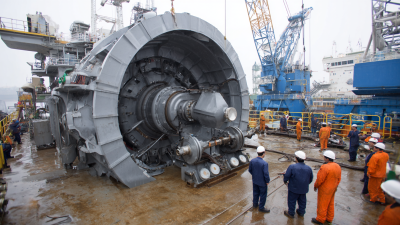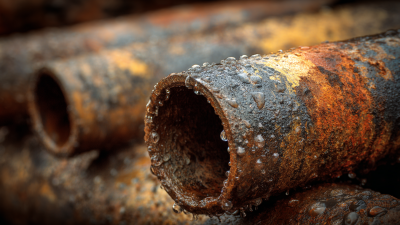

 In today’s fast-moving world of oil and gas, making operations as
efficient as possible is really important. One pretty exciting
development we've seen lately is the use of
Polyurethane Hydrocyclones. These are specially designed
to improve separation processes, which are super crucial in many industrial setups. Here at
Shanghai Shangjiang Petroleum Engineering Equipment Co., Ltd., we’re all about pushing the boundaries of what's
possible in separation and filtration tech for this industry. Our team’s constant drive for innovation has
put us right at the forefront when it comes to
cyclone separation tech. By adding Polyurethane Hydrocyclones into existing systems,
companies can see big improvements in how well they separate materials, trim down operational costs, and overall,
get more done. This guide is all about sharing tips and best practices to get the most out of
Polyurethane Hydrocyclones, and showing how our expertise can really help you
achieve better results in your operations.
In today’s fast-moving world of oil and gas, making operations as
efficient as possible is really important. One pretty exciting
development we've seen lately is the use of
Polyurethane Hydrocyclones. These are specially designed
to improve separation processes, which are super crucial in many industrial setups. Here at
Shanghai Shangjiang Petroleum Engineering Equipment Co., Ltd., we’re all about pushing the boundaries of what's
possible in separation and filtration tech for this industry. Our team’s constant drive for innovation has
put us right at the forefront when it comes to
cyclone separation tech. By adding Polyurethane Hydrocyclones into existing systems,
companies can see big improvements in how well they separate materials, trim down operational costs, and overall,
get more done. This guide is all about sharing tips and best practices to get the most out of
Polyurethane Hydrocyclones, and showing how our expertise can really help you
achieve better results in your operations.
Polyurethane hydrocyclones are really starting to catch on in different industrial settings, mainly because they’re super efficient at separating materials and last a long time. What’s cool about them is their resistance to corrosion and their lightweight design, which makes them perfect for tough environments. Recently, there’s been a lot of focus on tweaking their design—like adding a flat bottom—to reduce the bypass effect. This small change can seriously boost how well they separate stuff, as some recent studies have shown.
Plus, newer designs that blend mechanical insights with data-driven modeling are showing some pretty promising results. For example, using a variable diameter solid rod helps prevent air core formation, which means there’s more room for effective separation. This improves the overall flow inside the cyclone and makes it work better. These new configurations are really making a difference in areas like water treatment and particle classification, so there’s definitely a push to rethink and upgrade existing systems to keep up with industry demands. All in all, this just shows how important continuous innovation is to make polyurethane hydrocyclones more effective across different sectors.
Getting the most out of a hydrocyclone really depends on a few important things. First off, the design itself is pretty critical — stuff like the shape, cone angle, and size matter a lot because they influence the centrifugal forces that do the separation work. tweaking these parts based on what you're processing and how you're running it can really make a difference in performance. Then, there’s the physical properties of the fluid — things like viscosity and density. These properties interact with the hydrocyclone’s design and affect how well it can separate particles of different sizes. For example, if the fluid’s viscosity is higher, you might need to adjust your approach to keep things running smoothly. Also, keeping the feed conditions steady—like flow rate and pressure—is super important because any fluctuations can mess with the separation efficiency. Basically, understanding and fine-tuning these factors is key to getting the best results out of polyurethane hydrocyclones in different industrial setups.
This bar chart illustrates the impact of various key factors on the efficiency of polyurethane hydrocyclones in industrial applications. Each factor directly influences separation efficiency, highlighting the critical aspects that should be optimized for improved hydrocyclone performance.
 Picking the right polyurethane hydrocyclone really matters if you want your industrial processes to run smoothly and efficiently. When you're comparing different options, it’s a good idea to think about what materials you’re working with, how fine or coarse you need the separation to be, and what kind of flow rate your system needs. Basically, you wanna match the hydrocyclone’s shape, size, and overall design with the stuff you're processing. Oh, and don’t forget about durability—since the polyurethane parts need to withstand wear and tear; that can really impact your maintenance costs and how smoothly everything runs.
Picking the right polyurethane hydrocyclone really matters if you want your industrial processes to run smoothly and efficiently. When you're comparing different options, it’s a good idea to think about what materials you’re working with, how fine or coarse you need the separation to be, and what kind of flow rate your system needs. Basically, you wanna match the hydrocyclone’s shape, size, and overall design with the stuff you're processing. Oh, and don’t forget about durability—since the polyurethane parts need to withstand wear and tear; that can really impact your maintenance costs and how smoothly everything runs.
Also, keep an eye on operational stuff like pressure and how dense the feed is. It’s worth setting some baseline performance standards so you can make fair comparisons between models. And, if you can, chat with the manufacturers—they usually know a lot about their designs and can give you tips. The best way to really know how well a hydrocyclone works for you? Run tests in real working conditions. That hands-on step can make all the difference in picking the perfect fit and boosting your plant’s productivity. Trust me, finding the right setup can lead to some pretty big gains in operational efficiency.
You know, when it comes to industrial stuff like polyurethane hydrocyclones, getting the operating conditions just right is kind of a big deal. It’s all about boosting throughput without risking things going sideways. Recent research shows that tweaking things like pressure, flow rate, and temperature carefully can bump up productivity by as much as 30%. That’s a pretty sweet jump—it not only helps speed things up but also tackles the rising need for better risk management in these complex systems. And honestly, using simulation software has become a game-changer. It allows companies to spot potential hiccups early on, which means less downtime and smoother operations overall.

On top of that, more and more companies are turning to advanced analytics to make smarter decisions. By integrating these systems with predictive tools, they can really seize opportunities during critical phases of their operations. From what I’ve seen, businesses that rely on real-time data insights can respond about 15% faster—helping them stay ahead of the game in a pretty competitive market. As the industry keeps evolving, understanding how all these factors play together and optimizing them is going to be key for growth and sustainability down the line.
Polyurethane hydrocyclones are pretty vital in many industrial setups, especially when it comes to separating solids from liquids. If you want them to work efficiently and last longer, regular maintenance is definitely the way to go. From what I’ve seen, those that are kept in good shape can often hit separation efficiencies of over 90%, which really boosts overall productivity. So, setting up a clear maintenance routine can make a big difference—better performance, less downtime, you know the drill.
One handy tip is to make a habit of inspecting the wear parts, like the inlet and vortex finders. Wear and tear there can seriously mess with how well they separate materials, which can end up costing you more in the long run. I’d say aim to check these at least twice a year—more if you're in a super abrasive environment—and always follow the manufacturer's recommendations. Also, don’t forget to keep an eye on the feed pump’s flow rate. It should stay within the recommended range; fluctuations can really throw off the separation process.
And when installing a new hydrocyclone, make sure everything lines up perfectly. Misalignment isn’t just an aesthetic issue—it can cause uneven wear and lower efficiency. Using laser alignment tools can save you from headaches down the line and help you get it right the first time. By sticking to these simple but effective maintenance practices, you’ll extend the life of your polyurethane hydrocyclones and keep things running smoothly and efficiently—trust me, it’s worth it.
Polyurethane hydrocyclones have really been making waves in different industries lately, mainly because they’re so good at sorting and separating materials. I came across a pretty interesting example from a mining operation that switched over to using polyurethane hydrocyclones instead of the usual metal classifiers. Wow, the results were impressive — they managed to bump up their throughput by about 20%, and at the same time, their equipment didn't wear out as quickly. Not only did this save them money on maintenance, but it also improved the purity of the mineral concentrates they produced. It just goes to show how trying out new, innovative materials can really take operations to the next level.
And it doesn’t stop there. In wastewater treatment, for instance, one facility decided to give polyurethane hydrocyclones a shot for separating solids from liquid waste. The outcome? They boosted their water recovery rate by around 30%, which made it easier for them to meet environmental standards. Plus, because polyurethane is so lightweight, it made installing and maintaining the equipment a lot simpler — another plus for efficiency. These stories really highlight how polyurethane hydrocyclones aren’t just a fancy trend; they’re actually changing the game across different sectors, making things more productive and eco-friendly.
: Polyurethane hydrocyclones offer exceptional separation efficiency, durability, corrosion resistance, and lightweight construction, making them suitable for demanding environments.
The design, including geometric configurations like cone angle and diameter, significantly influences the centrifugal forces within the hydrocyclone, thereby affecting separation efficiency.
Recent advancements include the incorporation of a flat bottom structure to minimize the bypass effect and the integration of mechanistic and data-driven models to improve efficiency.
The fluid's viscosity can influence the separation process; higher viscosity fluids may require tailored operational strategies to maintain optimal efficiency.
Consistent feed conditions such as flow rate and pressure are crucial, as fluctuations can lead to variations in separation efficiency.
Features such as a variable diameter solid rod have been introduced to inhibit air core formation, optimizing the flow field and enhancing effective separation space.
Polyurethane hydrocyclones can be effectively utilized in applications such as water treatment and particle classification.
Continuous innovation is important for maximizing operational capabilities and meeting the evolving demands of various industrial sectors.
If you're looking to boost efficiency in industrial setups, Polyurethane Hydrocyclones really stand out thanks to their unique features and benefits. These separation devices are pretty crucial when it comes to optimizing performance—they handle things like flow rate, feed concentration, and operational conditions. Choosing the right Polyurethane Hydrocyclone isn't just a shot in the dark; it’s all about really understanding the specific needs of your application to make sure the equipment fits perfectly and performs smoothly.
And hey, keeping those units running at their best is key. That means regular maintenance—it's the best way to extend their lifespan and keep efficiency high. Looking at case studies from the industry can be super helpful, offering real-world insights on how companies have successfully used Polyurethane Hydrocyclones to improve their separation processes. At Shanghai Shangjiang Petroleum Engineering Equipment Co., Ltd., we're all about continuously improving these technologies because we're committed to providing top-notch solutions for the oil and gas industry.






